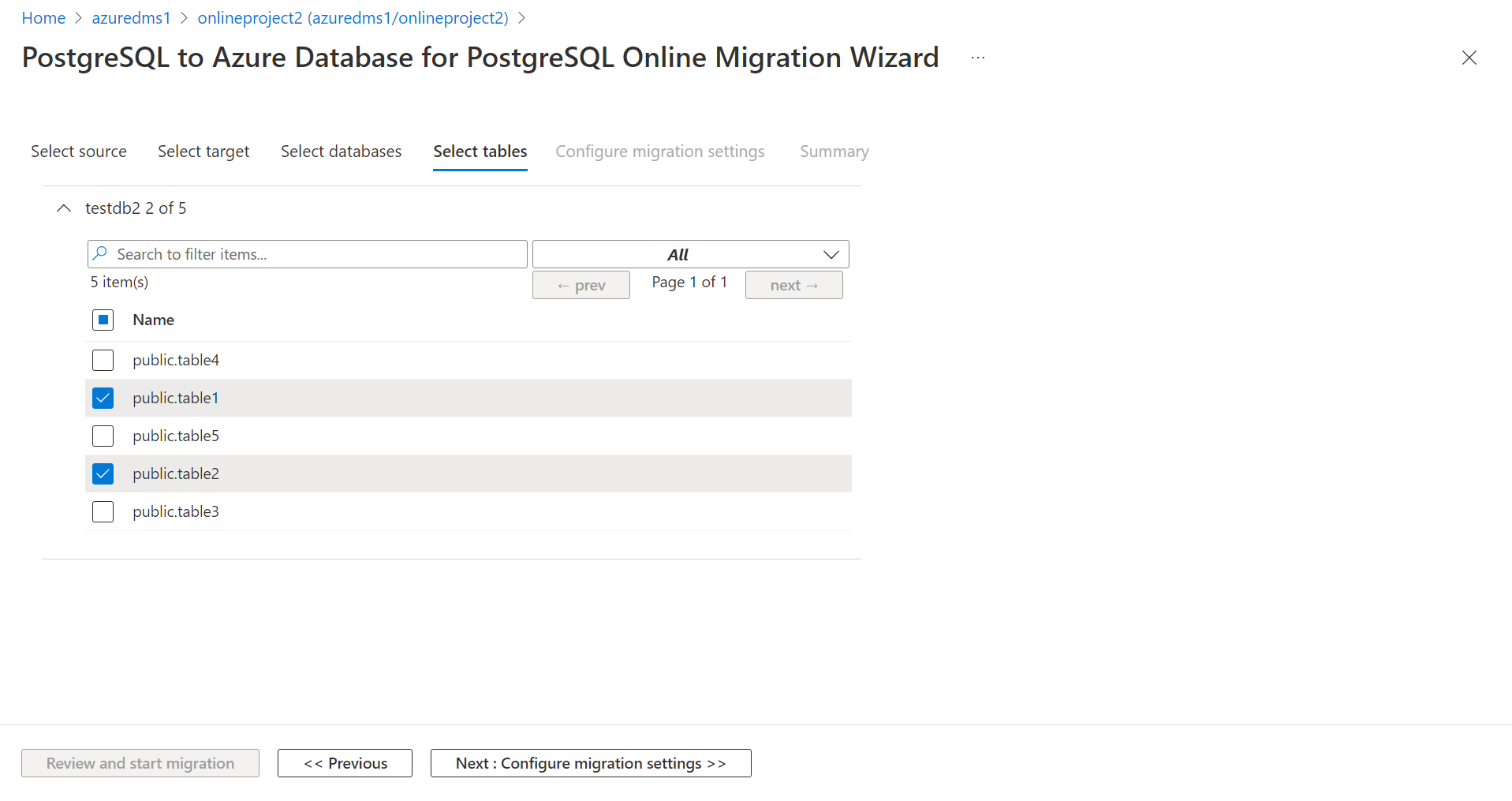Known issues and limitations with online migrations from PostgreSQL to Azure Database for PostgreSQL
Important
We recommend that you use the new migration service in Azure Database for PostgreSQL for a more streamlined and efficient migration experience. This service simplifies the process by supporting a variety of source environments, ensuring a hassle-free transition to Azure Database for PostgreSQL.
This article describes known issues and limitations associated with online migrations from PostgreSQL to Azure Database for PostgreSQL using Azure Database Migration Service (DMS).
Online migration configuration
The lowest PostgreSQL source versions supported is 9.4, and the highest target version supported is 14.9.
Only migrations to the same or a higher version are supported. For example, migrating PostgreSQL 9.5 to Azure Database for PostgreSQL 9.6 or 10 is supported. Migrating from PostgreSQL 11 to PostgreSQL 9.6 isn't supported.
To enable logical replication in the source PostgreSQL
postgresql.conffile, set the following parameters:Parameter Description wal_levelSet as logical. max_replication_slotsSet at least the maximum number of databases for migration. If you want to migrate four databases, set the value to at least 4.max_wal_sendersSet the number of databases running concurrently. The recommended value is 10.Add the DMS agent IP to the source PostgreSQL
pg_hba.conf.Make a note of the DMS IP address after you finish provisioning an instance of Azure Database Migration Service.
Add the IP address to the
pg_hba.conffile:host all 172.16.136.18/10 md5 host replication postgres 172.16.136.18/10 md5
The user must have the REPLICATION role on the server hosting the source database.
The source and target database schemas must match.
Size limitations
- You can migrate up to 1 TB of data from PostgreSQL to Azure Database for PostgreSQL, using a single DMS service.
- DMS allows the users to pick tables inside a database that they want to migrate.
Behind the scenes, the pg_dump command takes the dump of the selected tables using one of the following options:
-Tto include the table names picked in the UI-tto exclude the table names not picked by the user
There's a max limit of 7,500 characters that can be included as part of the pg_dump command following the -t or -T option. The pg_dump command uses the count of the characters for selected or unselected tables, whichever is lower. If the count of characters for the selected and unselected tables exceed 7500, the pg_dump command fails with an error.
For the previous example, the pg_dump command would be:
pg_dump -h hostname -u username -d databasename -T "\"public\".\"table_1\"" -T "\"public\".\"table_2\""
In the previous command, the number of characters is 55 (includes double quotes, spaces, -T, and slash)
Data type limitations
Limitation: If there's no primary key on tables, changes might not be synced to the target database.
Workaround: Temporarily set a primary key for the table for migration to continue. Remove the primary key after data migration is finished.
Limitations with online migration from AWS RDS PostgreSQL
When you try to perform an online migration from Amazon Web Service (AWS) Relational Database (RDS) PostgreSQL to Azure Database for PostgreSQL, you might encounter the following errors:
Error: The default value of column '{column}' in table '{table}' in database '{database}' is different on source and target servers. It's '{value on source}' on source and '{value on target}' on target.
Limitation: This error occurs when the default value on a column schema differs between the source and target databases.
Workaround: Ensure that the schema on the target matches the schema on the source. For more information on migrating the schema, see the Azure Database for PostgreSQL online migration documentation.
Error: Target database '{database}' has '{number of tables}' tables whereas source database '{database}' has '{number of tables}' tables. The number of tables on source and target databases should match.
Limitation: This error occurs when the number of tables differs between the source and target databases.
Workaround: Ensure that the schema on the target matches the schema on the source. For more information on migrating the schema, see the Azure Database for PostgreSQL online migration documentation.
Error: The source database {database} is empty.
Limitation: This error occurs when the source database is empty. You probably selected the wrong database as the source.
Workaround: Double-check the source database you selected for migration, and then try again.
Error: The target database {database} is empty. Migrate the schema.
Limitation: This error occurs when there's no schema on the target database. Make sure the schema on the target matches the schema on the source.
Workaround: Ensure that the schema on the target matches the schema on the source. For more information on migrating the schema, see the Azure Database for PostgreSQL online migration documentation.
Other limitations
The database name can't include a semicolon (
;).A captured table must have a primary key. If a table doesn't have a primary key, the result of DELETE and UPDATE record operations are unpredictable.
Updating a primary key segment is ignored. Applying such an update is identified by the target as an update that didn't update any rows. The result is a record written to the exceptions table.
If your table has a
JSONcolumn, any DELETE or UPDATE operations on this table can lead to a failed migration.Migration of multiple tables with the same name but a different case might cause unpredictable behavior and isn't supported. An example is the use of table1, TABLE1, and Table1.
Change processing of [ CREATE | ALTER | DROP | TRUNCATE ] table DDLs isn't supported.
In Database Migration Service, a single migration activity can only accommodate up to four databases.
Migration of the pg_largeobject table isn't supported.
